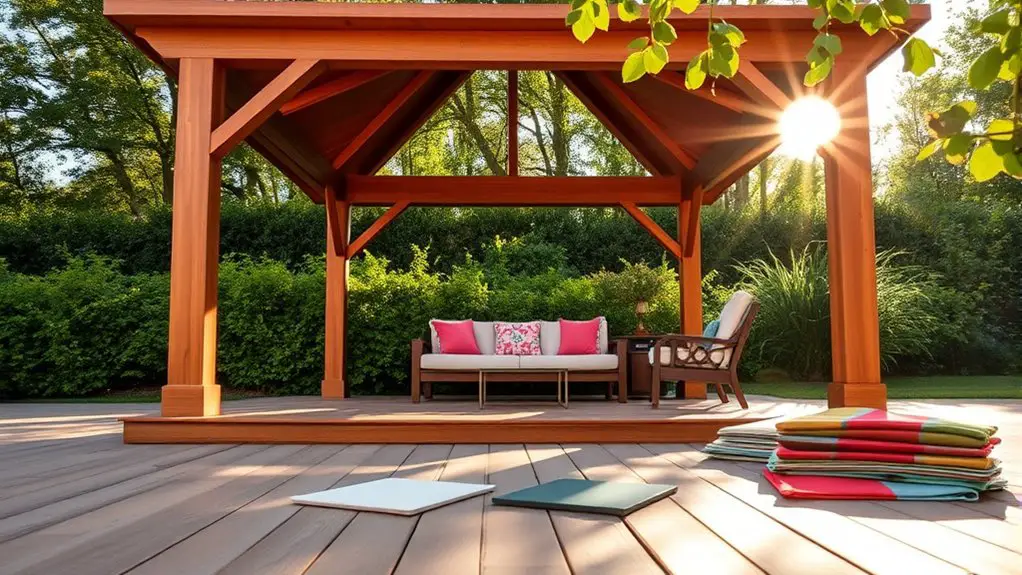When choosing materials for your gazebo, consider your local climate and environment to guarantee durability and longevity. For humid climates, wood like cedar or pressure-treated pine works well, while metal options offer exceptional durability and low maintenance in various conditions. Don’t forget about aesthetics; blending materials can enhance visual appeal. Understanding the unique properties of different materials can help you make informed choices that suit both function and style. There’s more to explore on this topic.
Understanding Your Climate and Environment
When selecting materials for your gazebo, understanding your climate and environment is vital, as these factors will greatly impact your choice. The climate impact on your gazebo can’t be overstated; materials must withstand the specific conditions you face. For instance, if you live in a humid area, moisture-resistant materials are imperative to avoid rot and decay. Conversely, in arid regions, you’ll need to take into account sun exposure and heat resistance.
Environmental factors such as wind patterns and local wildlife also play a role in material selection. Strong winds might necessitate sturdier structures, while insect-resistant options can safeguard against pests. Each choice you make should align with the freedom you want in your outdoor space, allowing you to enjoy it without worry. Ultimately, evaluating these elements guarantees that your gazebo becomes a lasting sanctuary, blending seamlessly with your surroundings while standing the test of time. Additionally, the choice of wood should consider local climate and weather patterns to ensure optimal durability and performance.
Exploring Wood Options for Your Gazebo
When selecting wood for your gazebo, you’ll want to evaluate popular options like cedar, redwood, and pressure-treated pine, each offering distinct aesthetic and functional qualities. Durability is essential, as different species can withstand environmental stressors like moisture and pests in varying degrees. Additionally, reflect on the maintenance each type requires; some woods demand more upkeep to preserve their beauty and integrity over time. Choosing a sustainable and eco-friendly material can enhance your gazebo’s appeal while being mindful of environmental impact.
Popular Wood Types
While the aesthetic appeal of your gazebo largely hinges on its design, the choice of wood plays an essential role in determining both its durability and maintenance requirements. When selecting the right wood type, consider these options:
- Cedar: Known for its natural resistance to decay and insects, cedar benefits include a beautiful grain and minimal maintenance.
- Pressure Treated Pine: This economical choice undergoes a treatment process that enhances its lifespan, making it a practical option for budget-conscious builders.
- Redwood: Like cedar, redwood offers excellent resistance to the elements, along with a stunning color that deepens over time.
- Mahogany: This exotic wood boasts rich tones and a smooth finish, providing elegance but requiring more upkeep.
Choose wisely, as your wood selection can greatly influence your gazebo’s overall experience.
Durability Considerations
Selecting the right wood for your gazebo isn’t just about aesthetics; it’s also about how well the material will withstand the test of time. You’ll want to evaluate the material strength and weather resistance of your choices. Cedar and redwood are popular for their natural resistance to decay and insects, offering a solid balance of durability and beauty. Pressure-treated pine is another option, providing structural integrity at a lower cost, though it may require additional weatherproofing. Hardwoods like teak are incredibly resilient but come at a premium price. Ultimately, understanding these factors will help you choose wood that not only looks great but also endures the elements, allowing you to enjoy your outdoor sanctuary for years to come.
Maintenance Requirements
Although choosing the right wood can enhance your gazebo’s aesthetic appeal, understanding the maintenance requirements is equally essential for its longevity. Different wood types demand varying levels of upkeep, so you’ll need to be proactive. Here are some maintenance tips to contemplate for your gazebo:
- Inspect the wood regularly for signs of rot or damage.
- Clean the surfaces every few months to prevent mold and mildew.
- Apply a protective sealant annually to protect against moisture.
- Repaint or stain every two to three years, depending on weather exposure.
With proper upkeep frequency, your gazebo can remain a stunning retreat for years. Embracing these maintenance strategies allows you the freedom to enjoy your outdoor space without worry.
The Benefits of Metal Gazebos
When considering a gazebo, metal options stand out for their exceptional durability and longevity. You’ll find that these structures can withstand harsh weather conditions without the frequent repairs that wood often requires. Plus, the low maintenance needs of metal gazebos mean you can spend more time enjoying your space and less time on upkeep. Additionally, steel frames are highly resistant to rust and corrosion, ensuring longevity with minimal maintenance requirements.
Durability and Longevity
While you might be drawn to the aesthetic appeal of wood or vinyl, metal gazebos offer unmatched durability and longevity that can make them a superior choice for your outdoor space. Their material strength guarantees they withstand the test of time, while their exceptional weather resistance means you won’t be constantly worrying about repairs.
Consider these benefits:
- Corrosion Resistance: Metal alloys can resist rust and deterioration.
- Impact Resistance: Less prone to damage from falling branches or hail.
- Fire Safety: Non-combustible materials safeguard against fire hazards.
- Stability: Robust structures that can endure high winds and heavy snowfall.
Investing in a metal gazebo means embracing freedom from frequent maintenance and the peace of mind that your outdoor retreat will last for years to come.
Low Maintenance Requirements
Since metal gazebos require minimal upkeep, they’re an ideal choice for anyone looking to enhance their outdoor space without the burden of constant maintenance. With their robust construction, metal structures resist rot, pests, and weather damage, allowing you to enjoy your gazebo rather than labor over it. Their low upkeep nature means you won’t spend weekends sanding or staining; a simple wash with soap and water is often all you need for easy cleaning. Additionally, many metal finishes are designed to withstand the elements, further reducing your maintenance worries. By choosing a metal gazebo, you’re investing in an elegant outdoor retreat that offers freedom from the tedious chores associated with traditional materials, letting you focus on what truly matters—enjoying your space.
Composite Materials: A Modern Choice
Composite materials have emerged as a popular choice for modern gazebos, blending durability with aesthetic appeal. When considering this option, you’ll appreciate its myriad benefits. Here are some key points to ponder:
- Sustainability factors: Many composites incorporate recycled materials, reducing environmental impact.
- Weather resistance: They withstand the elements, minimizing warping or rotting.
- Variety in design: Composites come in various colors and textures, allowing for customization.
- Easy installation tips: Lightweight and pre-cut options can simplify the assembly process, making it a DIY-friendly choice. Additionally, their low maintenance needs make them an appealing choice for busy homeowners.
Maintenance Considerations for Different Materials
When selecting materials for your gazebo, understanding the maintenance requirements is essential to guarantee longevity and aesthetic appeal. Different materials come with varied upkeep needs. For instance, wood demands regular staining and sealing to withstand the elements; this includes effective cleaning techniques to remove mildew and prevent rot. On the other hand, metal structures often require rust prevention measures and occasional polishing to maintain their shine. Composite materials are relatively low-maintenance, but they still benefit from periodic cleaning to avoid grime buildup. When considering weatherproofing options, make sure you choose the right sealants and treatments tailored to the material. Additionally, be mindful of common issues such as canopy damage and rust spots that can arise from insufficient maintenance. A thorough understanding of these maintenance considerations not only enhances your gazebo’s durability but also preserves its beauty over time. Ultimately, the right choice of materials, coupled with proper maintenance, allows you to enjoy your outdoor retreat without the worry of deterioration.
Aesthetic Appeal and Design Versatility
While selecting materials for your gazebo, it’s essential to contemplate both aesthetic appeal and design versatility, as these elements greatly influence your outdoor space’s overall atmosphere. The right materials can harmonize with nature while showcasing your style.
Consider the following aspects to enhance your gazebo’s look:
- Color combinations: Choose shades that complement your home and surroundings.
- Design trends: Stay updated on what’s popular to guarantee your gazebo feels current and relevant.
- Material variety: Blend different materials like wood, metal, or fabric for a unique design.
- Customization options: Explore finishes and textures that allow for personal expression. Additionally, selecting materials that offer weather resistance can help ensure your gazebo withstands local climate challenges.
Budgeting for Your Gazebo Materials
Budgeting for your gazebo materials requires careful consideration, especially since costs can vary widely based on choices. To make the most of your investment, start by identifying cost-effective options that don’t compromise on quality. Think about materials like treated wood, vinyl, or metal; each has its own price range and durability.
Next, focus on material sourcing. Local suppliers might offer better deals than big-box stores, and don’t forget to explore recycled or reclaimed materials for unique aesthetics at lower costs.
Consider long-term maintenance expenses too; sometimes, a cheaper initial purchase can lead to higher upkeep costs down the line. Additionally, selecting materials based on durability and maintenance will ensure your gazebo withstands various weather conditions and minimizes future costs.
Finally, always factor in additional elements like hardware, permits, and labor if you’re hiring help. By carefully mapping out your budget and prioritizing your needs, you’ll create a stunning gazebo that aligns with your vision and financial freedom.
Frequently Asked Questions
How Long Does It Take to Build a Gazebo?
Building a gazebo’s like planting a seed; it takes patience. Typically, a construction timeline ranges from a weekend to a week, depending on your skill level and the complexity of the assembly involved.
Can I Relocate My Gazebo Once Installed?
You can relocate your gazebo, but it’s essential to take into account relocation challenges. If the gazebo’s foundation is solid, it may require additional work to guarantee stability and proper setup in the new location.
Are Permits Required for Gazebo Construction?
When it comes to permits for gazebo construction, you’ll want to dot your i’s and cross your t’s. Different permit types and construction regulations vary by location, so check your local guidelines to stay compliant.
What Size Gazebo Is Best for My Yard?
To determine the best gazebo size for your yard, consider your yard dimensions and desired use. Ideal gazebo proportions should balance functionality and aesthetics, ensuring it complements your space without overwhelming its natural beauty.
Can I Customize My Gazebo Design Easily?
Absolutely, you can customize your gazebo design! With various gazebo styles and unique design features, you’re free to create a personalized outdoor paradise that reflects your taste and enhances your backyard beauty effortlessly.

